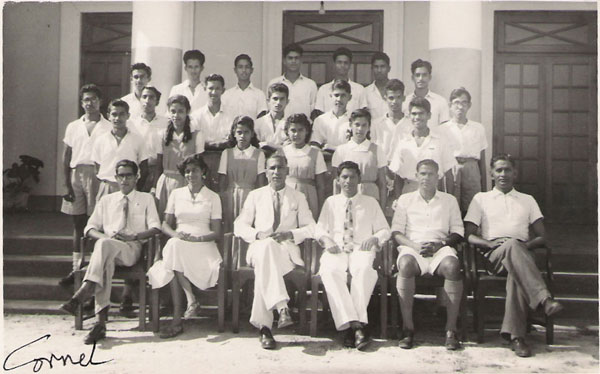Leo Noronha taught me English Language and English Literature in 1954 in the final year of my secondary schooling at The Goan High School, Mombasa, Kenya. This was a very long time ago but I recall ever so much of his kindness and great competence as a teacher to all in his care. In particular, he was innovative in getting us to write essays on challenging single word topics like 'Pockets', 'Trees', Thumbs, and 'Walls'! While these were demanding requirements for 500 word essays, it forced us to think creatively in addition to all the other work we had to do in preparation for the English Language Cambridge School Certificate examination. In the same eight subject examination we took English Literature where the required Shakespeare text happened to be Macbeth and there was the study of novels/plays like Buchanan's Thirty-nine Steps and Shaw's Arms and the Man. But Leo was a voracious reader himself and encouraged us to read widely by consistently ordering new books for the school library. I also believe that he had taught Geography and Religious Knowledge at the school. Further, he encouraged us to write and send material for publication to the local newspaper (The Mombasa Times) and UK published magazines like Boys Own. Indeed, one of my earliest articles to get accepted by Boys Own Magazine was about a cycling trip organised by Leo from Mombasa to Kilifi and back that turned out to be on an incredibly hot day. The magazine editor could not resist including an original cartoon of us roasting in the sun with my piece!
Leo could never stop telling us about what a great place Nagpur in India was where he had obtained his degree and also his teaching qualification. He could go on and on but invariably capture our imagination about the exciting life he had there but of course, had given up all this to teach us in the wilds of East Africa! In turn, we his students, became quite adept at asking seemingly innocent questions that would totally side track Leo into fascinating stories that had nothing to do with the lessons he was supposed to be teaching but it did no harm! Leo also loved the colour green long before it became iconic environmentally. Thus he rode a bicycle that was green in colour and marked our work, always on time, in green ink! His written comments were always highly supportive and constructive and he invariably read out the best essays to the whole class.
Leo Noronha had been recruited from India to teach in Kenya along with another contemporary teacher, Neves Pereira, who ironically passed away only some six months earlier and about whom I had also presented a tribute in the Goan Voice (UK). It had struck me from the first time I met Leo, that he was totally vocationally oriented. Thus, I doubt he ever contemplated wishing to do anything else but to teach with unbounded enthusiasm. He did take up the headship of the Goan High School Mombasa for a year and very briefly in Nairobi too but subsequently returned to his first love of classroom teaching in Canada.
Our Indian educated teachers however, were in a bit of a bind when they opted to teach in Kenya. On the one hand, they had the advanced qualifications and skills not available to us in Kenya as university education was limited to just one institution in all of East Africa at Makerere College in Kampala, Uganda. For huge territories like Kenya, Uganda, Tanganyika and Zanzibar, getting into Makerere to study for a degree was beyond our wildest dreams on completing secondary school. However, some of us opted to undertake a two-year primary school teacher training course and Leo Noronha encouraged me to do so rather than to proceed to study in India. Indeed, I recall him saying..."you never know, you may be able to proceed to a degree course in the UK in due course after the teacher training course" and he was kind enough to provide me a reference for entry to the Coast Teacher Training College in Mombasa. But clearly, our teachers like Leo and Neves were acutely aware that, their Indian degree qualifications were rated by the Kenya colonial administration as sub degree qualifications or equivalent to 'A' level qualifications. Thus, they were encouraged to apply to study for a degree in the UK on a Kenya Government scholarship. While clearly an attractive option, it did mean that they had to sacrifice earnings for a minimum of three years as well as to revert to being students alongside eighteen year olds. Thus, somewhat indirectly, our teachers were competing with us (their students) for degree level courses in the UK after undertaking two further years of full time education for 'A' levels only available in Nairobi to a small number of students with adequate resources. As this option was impossible for me on cost grounds, on Leo's advice, I taught myself three A level subjects through sheer hard work and by drawing on texts from our limited local library whilst also teaching full time.
Leo won a Kenya Government scholarship and began study for a degree in English at Reading University in 1956. On his return, I was keen to discover what his experience was like and l recall in particular, his honesty in saying that he had found it fairly tough going. He was also distracted by much extra curricular activity and the opportunity to travel around Europe but above all, he had to learn how to undertake literary analysis. His experience in the arts like most in Indian universities was that they were trained to write well descriptively but not analytically. Thus, he said, "it was a big struggle initially to learn how to be analytical." This put much fear into me as I was hoping to become a UK student myself but Leo was once again kind enough to explain to me how one could develop the necessary higher education skills. Fortunately, he did not tell me, because he probably didn't know, that university education in the UK was incredibly elitist. In the 1950s, only some 4% of eighteen year olds could gain a university place. In contrast today (2009) it is close to being 50%. There clearly would have been a strong possibility that I would have discounted myself then, from entering such a formidable race even though some 6% entered university by 1962 when I eventually became a UK student for a first degree.
I lost track of Leo after leaving Mombasa in 1961 but after many years in the UK, having obtained his address in Calangute, Goa, I decided to surprise him with a knock at the door of his flat (we had no telephones in any case), on a visit to Goa in 1988. I was certain that he would not recognise me after so many years but was truly staggered when he opend the door and simply said "Dr DaCosta, I presume, welcome to my humble abode." We had an excellent chat for the best part of three hours and I realised that he had followed up the progress of most of his former students and indeed asked me about several of them. In my case, again to my surprise, he recounted reading articles I had got published in the monthly magazine Goa Today and said he was specially interested in one titled 'Towards The Making of a Modern University for Goa.' I had completely forgotten about this article but he recounted some of the key points I had made in it. I also discovered that he had kept himself busy writing articles for publications and writing critiques of published material. He also emphasised several times that it was an honour for him that I had progressed to a doctorate. It reminded me of the well known quote that "a good teacher is like a candle---it consumes itself to light the way for others."
We were sorry to part company but agreed that we would try and meet again if possible. This unfortunately didn't happen but I will have to keep to a little promise I hade made to him that, someday I would endeavour to visit Nagpur--- the eternal city of his youth and huge romantic imagination.

Click to enlarge
Goan School Mombasa, Class of 1954
First row: Teachers: C. Correia, May Soares, Principal Ildefonso de Souza, Leo Noronha, Joe Fernandes, Ismael de Souza.
Secord row: Oscar Quadros, Clarice de Souza, Thelma Gomes, Doreen Sequiera, Greta Laurent, Oscar de Mello
Third row: Oscar Pereira, Joe Viegas, Francis Lobo, Francis Braganza, Rudolf Nobay, Norbert de Souza, Leo Correia
Fourth row: Abdulla Sheikh, Anthony L de Souza, Cornel DaCosta, Michael Costa-Correa, Manuel Castellino, Menino Viegas and A. Michael de Souza.
Photo: Cornel Da Costa
|

